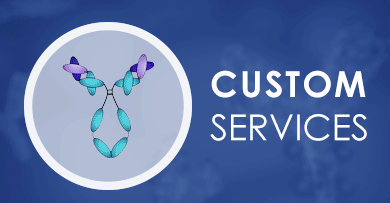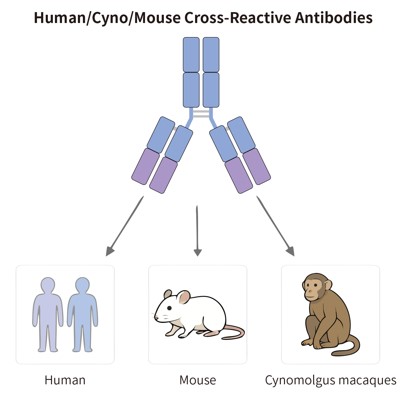 Loading...
Loading...

Human/Cyno/Mouse Cross-Reactive Antibody Products
Introduction
Human/cyno/mouse cross-reactive antibodies are molecules that can bind to the same or similar antigens in humans, cynomolgus monkeys (cyno), and mice. These antibodies are valuable tools in drug development because they allow for the testing of therapeutic candidates in both human and animal models.
 Fig.1 Schematic of Human/Cyno/Mouse Cross-reactive Antibodies.
Fig.1 Schematic of Human/Cyno/Mouse Cross-reactive Antibodies.
Significant Advantages of Human/Cyno/Mouse Cross-Reactive Antibodies
The strategic adoption of these multi-species reactive molecules delivers quantifiable benefits that streamline preclinical development and significantly enhance the predictability of clinical outcomes.
Streamlined Preclinical Translation and Pharmacology
Utilizing the same antibody across different species ensures consistent pharmacology, effectively reducing the translational gap between in vitro and in vivo studies. This allows for direct and high-fidelity testing of the therapeutic's intended Mechanism of Action (MOA) in relevant preclinical species. For example, if a cross-reactive antibody blocks a specific receptor in a human cell assay, the same molecular interaction is assured to occur when administered to a mouse or cyno, validating the MOA across the phylogenetic spectrum. This consistency is paramount for interpreting dose-response relationships and establishing effective therapeutic windows.
Enhanced Data Consistency and Avoidance of Surrogates
The most tangible advantage is the complete elimination of the need for species-specific surrogates. This removes the resource burden associated with their design, production, functional validation, and subsequent regulatory documentation. By using a single molecule, data consistency is inherently maintained across efficacy assessment (typically in mouse models) and safety/toxicology assessment (typically in cyno models). This prevents data variability that often arises when comparing the efficacy results of a surrogate to the toxicity results of the human lead candidate, thus building a more robust and unified dataset for regulatory submission.
Simplified CMC and Accelerated Regulatory Pathway
Using a single molecule for both preclinical and eventual clinical use dramatically simplifies Chemistry, Manufacturing, and Controls (CMC) requirements. Analytical and quality control standards can be applied to one drug substance, simplifying manufacturing processes, stability testing, and documentation.
Applications Across Translational and Molecular Biology
The utility of cross-reactive antibodies spans from fundamental research to the most advanced therapeutic modalities.
Direct In Vivo Efficacy and Safety Assessment
The mouse-reactive component is critical for direct in vivo efficacy assessment. For instance, the successful development of a cross-reactive anti-PD-1 antibody allows researchers to test the human lead molecule in syngeneic or humanized mouse tumor models, providing concrete evidence that the immune-modulatory effect translates to anti-tumor activity and prolonged survival in vivo.
The cynomolgus-reactive component is mandatory for IND-enabling toxicology. The drug's safety profile and the establishment of the No Observed Adverse Effect Level are derived from studies using the exact molecule intended for human use, minimizing the risk of unpredictable first-in-human toxicities. The commitment of Creative Biolabs to developing molecules with robust cyno cross-reactivity directly de-risks the most crucial stage of preclinical development.
Overcoming Immune Tolerance and Challenging Targets
The specialized screening platforms at Creative Biolabs are often required to generate antibodies against targets with high human-mouse homology, where immune tolerance normally prevents an immune response in standard mice. The cross-reactive nature confirms that the antibody is successfully engaging a critical, functional epitope despite high sequence conservation, thereby validating the target's relevance. Examples include the successful generation of antibodies against critical immune regulators like SIRP-alpha and NKp46 that maintain functionality across all three species.
Why Choose Us?
For over 20 years, Creative Biolabs has specialized in navigating the intricate biological and engineering complexities required to develop and validate high-quality cross-reactive antibodies. Our expertise directly translates into enhanced success rates and accelerated timelines for our clients.
- Proprietary High-Throughput Screening: We employ advanced platforms that not only screen for binding affinity to the human target but simultaneously screen against cyno and mouse orthologs, ensuring the early identification of naturally occurring or engineered cross-reactive clones.
- Rigorous Functional Validation: Our commitment extends beyond simple binding. Every cross-reactive lead is subjected to multi-species functional assays to verify equivalent potency and MOA. This meticulous process includes detailed KD analysis via SPR, confirming the crucial affinity balance necessary for accurate dose translation.
- Translational Partnership: Creative Biolabs provides fully characterized, regulatory-ready reagents that directly enable preclinical success, serving as a trusted partner in mitigating translational risk and ensuring the seamless progression of novel therapeutics from the lab to the clinic.
FAQ
What is the single most critical biological challenge in developing tri-species cross-reactive antibodies?
The critical challenge is achieving epitope conservation and subsequent affinity balancing across the three species. Minor sequence differences in the animal orthologs can lead to significant variations in KD, potentially resulting in inaccurate predictions of the therapeutic window or safety profile. Creative Biolabs addresses this by employing rational design and affinity maturation techniques focused on stabilizing binding to the conserved functional domain.
How does the mouse-reactive component primarily accelerate drug development?
The mouse-reactive component allows for the human lead candidate to be tested in mouse models of disease for proof-of-concept efficacy and MOA studies. This direct testing avoids the need to wait for a surrogate, providing immediate, high-confidence in vivo data that validates the drug's potential before committing to costly cynomolgus toxicology studies.
Why is cross-reactivity with the cynomolgus monkey so crucial for regulatory bodies?
Cynomolgus monkeys are the accepted non-rodent model for Good Laboratory Practice (GLP) toxicology studies required for an IND application. Using a cyno-cross-reactive human drug candidate ensures that the systemic toxicity and safety margins are established using the exact molecule that will be administered to humans, which is a fundamental requirement for defining the safe starting dose.
Can a cross-reactive antibody be used for diagnostic or PD studies?
Absolutely. Cross-reactive antibodies are highly valued as molecular tools for simultaneous Pharmacodynamic (PD) marker analysis across human and animal tissues. For instance, Creative Biolabs custom-designs cross-reactive antibody panels for flow cytometry, allowing researchers to use the exact same panel to monitor immune cell activation and target engagement in both human PBMCs and cyno blood samples.
-
- Species Reactivity: Human
- Type: Polyclonal Antibody
- Application: Cross Reactivity Study
-
- Species Reactivity: Pig
- Type: Polyclonal Antibody
- Application: Cross Reactivity Study
-
- Species Reactivity: Pig
- Type: Polyclonal Antibody
- Application: Cross Reactivity Study
-
- Species Reactivity: Cat
- Type: Polyclonal Antibody
- Application: Cross Reactivity Study
-
- Species Reactivity: Monkey
- Type: Polyclonal Antibody
- Application: Cross Reactivity Study
-
- Species Reactivity: Rabbit
- Type: Polyclonal Antibody
- Application: Cross Reactivity Study
-
- Species Reactivity: Human
- Type: Polyclonal Antibody
- Application: Cross Reactivity Study
-
- Species Reactivity: Dog
- Type: Polyclonal Antibody
- Application: Cross Reactivity Study
-
- Species Reactivity: Human
- Type: Monoclonal Antibody
- Application: Cross Reactivity Study
-
- Species Reactivity: Human
- Type: Monoclonal Antibody
- Application: Cross Reactivity Study
-
- Species Reactivity: Human
- Type: Monoclonal Antibody
- Application: Cross Reactivity Study
-
- Species Reactivity: Human
- Type: Monoclonal Antibody
- Application: Cross Reactivity Study
-
- Species Reactivity: Human
- Type: Monoclonal Antibody
- Application: Cross Reactivity Study
-
- Species Reactivity: Human
- Type: Monoclonal Antibody
- Application: Cross Reactivity Study
-
- Species Reactivity: Human
- Type: Monoclonal Antibody
- Application: Cross Reactivity Study
-
- Species Reactivity: Human
- Type: Monoclonal Antibody
- Application: Cross Reactivity Study
-
- Species Reactivity: Human
- Type: Monoclonal Antibody
- Application: Cross Reactivity Study
-
- Species Reactivity: Human
- Type: Monoclonal Antibody
- Application: Cross Reactivity Study
-
- Species Reactivity: Human
- Type: Monoclonal Antibody
- Application: Cross Reactivity Study
-
- Species Reactivity: Human
- Type: Monoclonal Antibody
- Application: Cross Reactivity Study
-
- Species Reactivity: Human
- Type: Monoclonal Antibody
- Application: Cross Reactivity Study
-
- Species Reactivity: Human
- Type: Monoclonal Antibody
- Application: Cross Reactivity Study
-
- Species Reactivity: Monkey
- Type: Monoclonal Antibody
- Application: Cross Reactivity Study
-
- Species Reactivity: Rat
- Type: Monoclonal Antibody
- Application: Cross Reactivity Study
-
- Species Reactivity: Human
- Type: Monoclonal Antibody
- Application: Cross Reactivity Study
Our customer service representatives are available 24 hours a day, from Monday to Sunday. Contact Us
Can't find the products you're looking for? Try to filter in the left sidebar.Filter By Tag
For Research Use Only. Not For Clinical Use.

